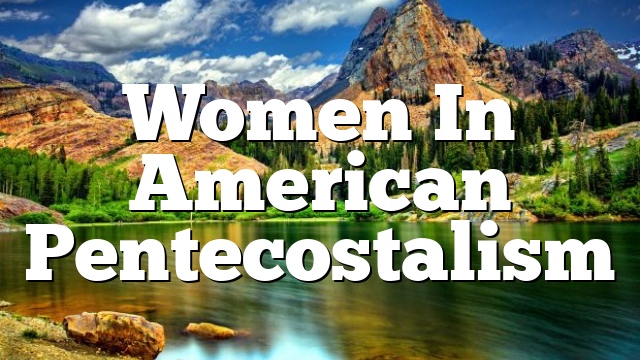Click to join the conversation with over 500,000 Pentecostal believers and scholars
Click to get our FREE MOBILE APP and stay connected
| PentecostalTheology.com



FOCUS:
WOMEN AND
Women
in American
Edith L. Blumhofer
Guest Editor
is required.
19
PENTECOSTALISM
Pentecostalism
in American Pentecostalism is
denominations
The
story
of women’s involvement
complex
and
confusing.
For the most
part,
Pentecostal
have not
readily
affirmed women as
pastors.
Women have thus been formally
excluded from institutional
positions
for which full ordination
And in the few Pentecostal denominations that offer women full
ordination,
that ordination has not
generally
translated into
equal access to
positions
of denominational
leadership.
On the other
hand, most Pentecostal denominations have
historically supported
female evangelists
and home and
foreign
missionaries. And women have
immeasurable cultural
authority
in Pentecostal
congregations.
valued individual testimonies of God’s
working
in participants’
that God
might
choose to manifest the
gifts
of the
Holy Spirit through any Spirit-filled believer,
female or
women at least some voice in
exercised
Early
Pentecostals
lives,
and
they
believed
male. These two
premises Pentecostal services.
assured
Pentecostalism
Pentecostalism.
The scholar who decides to
study
the role of women in American
quickly
learns that there is no
single narrative,
but there are
many
stories. For
every story
of affirmation there is another of frustration or
repression.
The material in the
following pages presents only
a few of the stories. Its
scope
is limited to Trinitarian
Anglo
My opening
reflection is culled from a paper given in a session on Gender and
Meaning
at the
January
1995 annual
meeting
of the American
Society
of Church
History.
The next two short
pieces by David Roebuck and Deborah Gill consider women’s collective
in two denominations-the Church of God
leadership experiences
(Cleveland)
and the Assemblies
of God. Kurt Berends has been
Fruits, the network
Pentecostalism in
Newfoundland,
working
in some
recently
discovered issues of The
Sheaf of
the First
to which Alice
Garrigus,
belonged.
an
early
leader of His
essay explores
the
biographical prominent
spiritual
formation of an
early
female
evangelist. Wayne
Warner’s
sketch of
Kathryn
Kuhlman documents the life of a
woman of a later era.
1
20
Perhaps
evangelist pastors;
.
extraordinary
dependence
on
by-laws
unpublished correspondence
of
policy. Frey
evangelistic
work. Scholars wide
discrepancies sometimes occurred.
most
suggestive
is the section of this issue devoted to selections from the
previously
Pentecostal
evangelist
Mae Eleanore
Frey.
The letters selected from her ministerial file contain
revealing nuggets
about the life of a female
who was also a wife and mother. Her
experience
with male
her encounters with the Ku Klux Klan and with E. W.
Kenyon; her occasional frustrations with Assemblies of God
policies;
her
advice from denominational
headquarters all
emerge
in these letters. Assemblies of God leaders
evidently endorsed
Frey’s ministry, and,
at a time when their constitution and
denied women the office of elder
(or pastor),
the denomination’s General
Secretary
saw no reason that
Frey
could not be a
pastor.
His
astonishing disregard
for the
personal dynamics
involved in settling a female
pastor
in a district that she knew did not want her is matched
only by
his
apparent disregard
for official denominational
was saved a showdown
by
the
unexpected
death of her husband which
opened
the
way
for her to continue in non-controversial
should be forewarned of the
possibility
of
between what
regulations
Pentecostalism.
mandated
and what
nor
representative.
It
of
Black and
Hispanic
stories that inform attitudes Pentecostal
community.
This FOCUS section is neither
comprehensive
admittedly ignores
the rich
experiences
female missionaries as well as those of women in
Oneness, independent,
In some of these
cases,
scholars do not
yet
have adequate
accessible sources to
begin
to unravel the relevant stories. With
only
one
exception,
these
essays
are
forthrightly
historical.
They do not deal with
change
over
time,
nor do
they
consider the attitudes toward women in the
contemporary growing independent
Pentecostal sector.
They do, however,
offer
glimpses
into different eras and
aspects
of the
story
of women and
Anglo-American
in so doing, they suggest
different
renderings
toward women
Pentecostalism. And for the
many richly
textured
within the American
2




Most Talked About Today